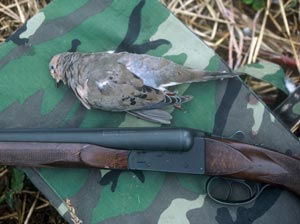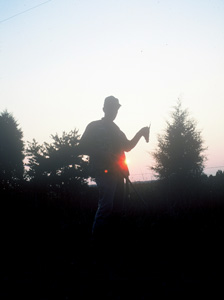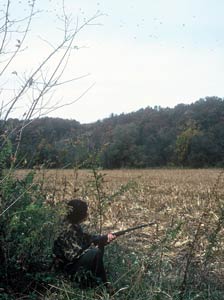
Oil up your shotguns, unpack your camo and shoot a few practice rounds. Dove hunting season is on tap. Although they can be hunted into January in most states, the real excitement of doves is that they offer some of the first shooting of the year.
Seasons typically open in early September, and now is the time to brush up on your dove knowledge. Here are some tips I've learned through trial and error over three decades of hunting this exciting gray gamebird with the long, pointed tail.

the main thing is to find one you're comfortable
with.
Use the right load: Although doves are strong enough to fly hundreds of miles south just months after being born, they're actually small-bodied birds and weigh just a few ounces. Because of this, early season doves are best brought down with a light load of #8 or #9 shot. Later in fall, as they gain weight from feeding, go with size 7 1/2 shot in heavier high brass shotgun loads.
Use the right gauge: Dove guns can range from a $100 single shot to a $10,000 European import with ornate engravings. The main thing is that it feels comfortable to the shooter and fits right. Any gauge from 12 to .410 will work, but the truth is only expert shots should use a 28 gauge or a .410.

Shotgun
Sometimes these light guns are given to youngsters with good intentions, but they make it supremely difficult for the novice who is just learning shooting skills to connect successfully on his or her quarry. Stick with a 16 or 20 gauge shotgun if you have a young or small-framed hunter you are introducing to the sport. The "kick" from these guns is very modest. Most hunters will be happiest with the 12 gauge.
Use the right choke for dove hunting: There is no single best choke for dove hunting. In some situations a wide-open skeet bore is good if birds are coming to a water hole or passing 15 to 25 yards from your position. For a more typical situation of pass shooting birds at random distances, go with improved, modified, or in a double, a combination of those two chokes. A full choke is seldom needed for dove hunting.
Wear camouflage or drab clothing and avoid movement: Blaze orange hunting apparel has its place in hunting, but not dove hunting. These birds see color and will flare when they detect bright-hued clothing that sticks out from its surroundings. A tan or olive-colored outfit is just about as good as camouflage clothing, but no matter what you wear, be sure to also avoid moving when a bird or flock is in view. Once they've been exposed to a bit of hunting pressure, doves become particularly wary and will flare if a hunter repositions himself or starts to raise his gun before they are in range.
Hunt early and hunt late: Opening day is the best time to hunt doves. The birds have not been shot at yet and they often fly close, presenting easy shots. Another reason to be in the field on opening day is that lots of other hunters are out. That tends to keep the birds moving from field to field, giving you more shooting opportunities.
Don't stash your dove gun away after the opener, though. After a few days, many hunters call it quits. By scouting, you can find fields with lots of birds that have settled down and little competition for them. The late season can be especially good.

Bring the right stuff: Gear for a dove hunt should include ear plugs, sunscreen, insect repellent, a hat with a brim to keep the sun out of your eyes, snacks, cold drinks or water, binoculars to track dove movements and shooting glasses or sunglasses. Decoys are an optional item you can add to the list.
Pre-scout before dove season opens: Spend at least a couple of afternoons scouting before dove season opens. Stay back far enough that the doves aren't alarmed by you or the vehicle and simply watch, using both your naked eyes and binoculars. Generally you'll see most flying activity from 2 or 3 p.m. onward. Try to figure out what routes the birds are using flying into fields and pick out several prime ambush points.
Focus on the right dove stand locations: When selecting a site for a dove stand, search for spots that are different than the surrounding habitat. Look for a lone tree sticking up along a fence row, a point of unplowed weedy land jutting out into a cultivated field, the corner of a field where it adjoins woods, a dip or gap in an otherwise straight line of tree tops. Take your stand close to these spots and you should enjoy fast shooting.
Avoid low angle shots: This is vital for safety during a dove hunt. A low angle shot could put your pellets flying towards another hunter's position. Pass up low-flying birds up. There will be plenty of others.
Don't stop your swing: This is one of the most common mistakes in shooting doves. Pull up on the bird, keep your cheek down tight to the stock and fire as the barrel covers the quarry. BUT KEEP SWINGING. If you don't, you'll surely send a wad of pellets flying through the air behind the quarry.
Avoid shooting at waterholes: You can hunt a water hole or pond that's currently being used by doves and enjoy fast and easy shooting. But if you want the birds to keep using it, set up instead on the main flyway they use approaching it and pass shoot. That way they won't associate the pond with danger and avoid it. Why burn out a good spot with just one afternoon's shoot?
Carry a hunting seat: When dove hunting, a small camouflaged fold-up stool with a compartment built in beneath the seat is a handy item to have. You can put extra shells, sunglasses, a drink, sandwiches and candy bars in the compartment and use the seat to reduce the strain on your legs and back throughout the long afternoon. Alternately, you can take a large plastic paint bucket and camouflage it, carrying your gear in it for the hike in and out and using it as a seat during the hunt.

when dove hunting instead of out in the
open.
Watch for flurries of dove activity: Some hunters think all the best shooting will occur in the final hour or two of daylight. That's not always the case. Often throughout the afternoon there will be "flurries" of dove activity when several groups of birds fly in and out of fields for five or ten minutes, followed by a lull in activity. Be ready when those waves of flights occur and you'll be well on your way towards a limit even before the last afternoon crescendo of action takes place.
Don't raise your gun too soon: If you do this, you lose the natural swinging motion that makes wingshooting a fluid, rhythmic activity of raising the gun, aiming and firing. Another problem with raising your gun too soon is that the birds might see your movement and flare out of range or swerve, making for a more difficult shot. Wait until the dove is just about into shooting range, meaning 40 yards or less, and then raise the shotgun in one smooth motion, firing as the barrel tracks ahead of the target.
Find the food doves eat: Good crop fields for doves include cut corn, wheat, peanuts, millet, sorghum, milo and sunflowers. Weed seeds such as thistle and croton are also favored by these birds.
Take care of your bounty: Dove hunting often takes place in hot weather, making spoilage of the game a concern. Don't pile doves up in the back of a hunting vest, but rather, lay them out in a shady area spread out so their body heat can dissipate. Alternately, you can carry a cooler with ice and put them in that, but be sure to spread them out.
Retrieve downed birds immediately: When birds are flying fast and furious, it's tempting to try to bag several before you go pick them up. That's usually a mistake, unless the cover is extremely low and open.
Doves are well camouflaged and easy to lose. You need to mark exactly where the quarry fell and walk directly towards it after shooting. It only takes a few minutes to retrieve the bird, and doves are too good on the dining table to waste. Of course if you have a well-trained retriever, he'll solve this problem for you.
Keep your hunting options open: Instead of figuring you'll hunt one spot, try to have two or three possible hunting locations lined up in advance. That way if one field has other hunters on it, or the birds just aren't flying well there, you can quickly have an alternative site to turn to.
Take cover: You don't need to build a blind, but try to locate a bit of natural cover to sit or stand next to. Find a cedar, fence post, brushy point or uncut row of corn to hide near. You don't have to hide yourself as well as you would to lure in a flock of wary ducks, but standing out in the open is a sure way to make doves flare out of range.
Keep these hunting tips in mind and you should have the makings for a delicious dinner at the end of the day in a dove field, as well as plenty of exciting memories of the elusive "gray ghost" to tide you over until your next hunt.
- 85286 views

